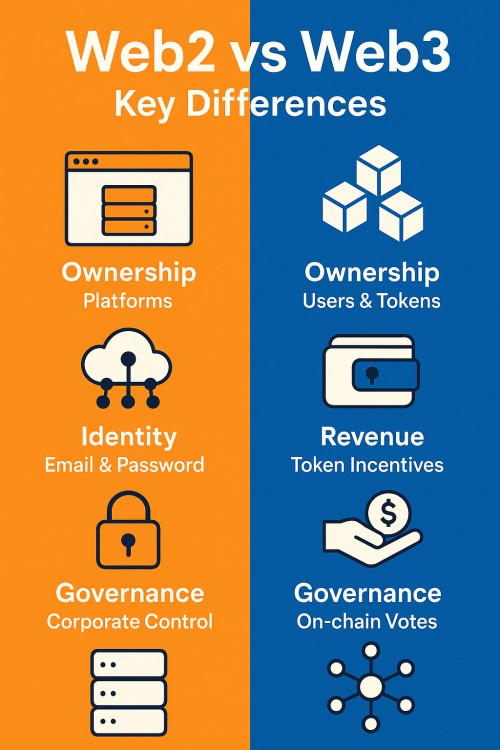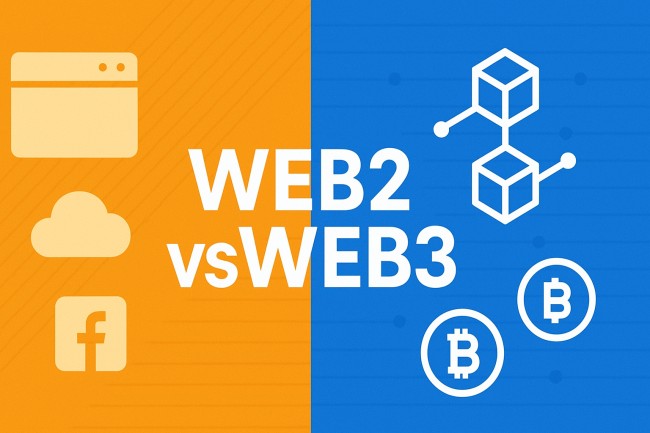An internet generation lasts little longer than a college degree. Dial-up pages gave way to interactive feeds, and now a fresh chapter competes for attention. The debate tagged “Web2 Vs. Web3” weighs centralised comfort against decentralised ownership.
Social platforms, cloud storage, and targeted adverts defined the past two decades, yet blockchains, tokens, and wallet-based identities promise a contrasting future.
Here in this article, we will discuss what exactly is Web 2 and Web 3 and discuss the key differences between Web2 and Web3 and also map the trade-offs that matter to everyday users.
What Is Web 2?
After the dot-com crash, participation became the winning feature. Tim O’Reilly’s 2004 conference popularised “Web 2.0”, capturing the shift from static pages to crowdsourced hubs.
Blogging engines such as Blogger, sharing platforms like Flickr, and wikis sparked bottom-up growth. YouTube’s 2005 launch proved video could scale; Twitter (2006) and Facebook Platform (2007) turned social graphs into programmable assets.
The iPhone placed a full browser in every pocket, while Amazon Web Services cut server bills so steeply that hobby projects reached global audiences overnight.
Technical building blocks
- Client experience – Ajax, later JSON over HTTPS, removed full-page reloads, creating chat-like speed.
- LAMP stack and micro-services – Linux, Apache, MySQL, PHP and later distributed queues let firms deploy dozens of times per day.
- Platform APIs – OAuth and REST gave external developers keys to user data—until rate limits changed without warning.
Economic scale and control
By late 2023 the “Magnificent Seven” tech firms – Apple, Microsoft, Nvidia, Amazon, Alphabet, Meta, and Tesla – held roughly $12 trillion in market value, outweighing the stock exchanges of several G20 nations combined.
Data sits at the centre: feeds refine attention, adverts fund servers, and profits accrue to the operator first. Incidents such as Cambridge Analytica’s misuse of Facebook profiles illustrate how centralised troves can be mined for political gain.
Strengths
- Ease of onboarding – An email and a password unlock near-zero-cost services.
- Rapid iteration – Closed control lets engineers run A/B tests hourly.
- Rich design – Native apps and CDNs push high-resolution media on any network.
Limitations
- Privacy – Click trails, contacts, and biometrics form detailed dossiers.
- Lock-in – Leaving a platform means losing audience, reviews, or in-game items.
- Censorship risk – One legal order or terms-of-service tweak can silence voices.
In short, Web 2 delivers speed and polish by trusting a handful of gatekeepers.
What Is Web 3?
Ethereum co-founder Gavin Wood coined “Web 3” in 2014 to imagine an internet secured by math rather than middlemen. Three pillars prop it up: decentralised consensus, native digital assets, and verifiable state stored on open ledgers.
The modern stack
- Base chains – Ethereum, Solana, Polkadot, and others finalise transactions across thousands of nodes.
- Scaling layers – Rollups batch work, cutting fees while inheriting base-layer security.
- Distributed storage – Protocols such as IPFS, Filecoin, and Arweave fragment files so no single data-centre failure breaks access.
- Wallet-based identity – Public-private key pairs replace email logins; reputation accrues through on-chain history.
- Middleware – Oracles, relays, and indexing services make external data query-able.
- Front-end clients – Progressive web apps call smart contracts via libraries like ethers.js.
Economic alignment
Tokens reward node operators, liquidity suppliers, artists, and early adopters. A stablecoin can plug into a lending engine; another team can bolt a margin tool on top. Innovation compounds because building blocks stay open by default.
Security trade-offs
Cryptography guards funds, yet holders bear the burden of seed-phrase safety. Hacks remain visible in public mempools, inviting rapid forensic work but also irreversible loss.
Regulation snapshot
Governments juggle consumer protection and open-market goals. The EU’s MiCA framework, scheduled for December 2025, seeks union-wide clarity, while the United States still relies on case law.
Current adoption
- Decentralised finance processed between $128 billion and $156 billion in total value locked during Q1 2025, depending on the tracker used.
- NFT sales contracted sharply to $23.8 million in Q1 2025 after 2021’s $2.9 billion art boom.
- Upgrades – Ethereum’s Cancun-Deneb (“Dencun”) fork in March 2024 introduced EIP-4844 proto-danksharding, slashing roll-up data costs and paving the way for 100k+ TPS targets.
Skill demand
Average smart-contract-developer pay reached $125 k in April 2025, with top offers above $250. Recruiters prize formal-verification expertise and zero-knowledge tooling.
In effect, Web 3 replaces tenancy with ownership: data, identity, and money follow the individual, not the platform.
Web 2.0 and Web 3.0 – Differences
| Dimension | Web 2.0 | Web 3.0 |
|---|---|---|
| Ownership | Platform stores everything | Wallet holds assets; rules in code |
| Revenue | Ads & subscriptions favour operator | Tokens, staking, fee-sharing reward participants |
| Identity | Email/password tied to provider | Public key proves control |
| Governance | Company decree | On-chain vote |
| Data storage | Proprietary databases | Blockchains & distributed file systems |
| Cross-app transfer | Walled gardens | Open standards |
| Censorship | Single switch can erase content | Content lives while any node serves it |
| Upgrades | Silent and rapid | Transparent, proposal-driven |
| Security model | Trust in corporation | Trust in consensus math |
| Build cost | Cheap hosting, fewer audits | Gas fees, formal review |
| User experience | Seamless, minimal friction | Wallet actions add steps, yet shrinking |

Ownership
Instagram photographs rest on Meta servers; an NFT persists so long as IPFS or Arweave pins the data. Control flips from corporate policy to cryptographic proof.
Revenue
Attention drives Web 2. In Web 3, liquidity providers earn trading fees, node operators collect block rewards, and secondary-sale royalties flow to artists automatically.
Identity & Privacy
OAuth logins unify profiles across apps, creating detailed targeting models. Wallet addresses expose only what the holder signs, and zero-knowledge proofs can confirm age or credit score without handing over raw fields.
Governance
When Twitter rebranded to X in 2023 the choice surfaced overnight. In token-governed projects proposals circulate for days; code merges only after threshold support, trading speed for predictability.
Data Transfer
A Facebook archive downloads as a zip file that few rivals can read. An ERC-20 token shows up in any compliant wallet or dashboard, letting communities migrate without friction.
Security
Central servers fail in outages that darken whole regions. Distributed ledgers continue unless an overwhelming majority goes offline. On the flip side, phishing drains wallets in seconds, and refunds remain rare.
Censorship Resistance
Legal takedowns travel through hosting providers in Web 2. Removing an IPFS-pinned file demands chasing every seeder, a far tougher ask for censors.
Cost & Efficiency
A blog runs for dollars a month, yet peak NFT drops once pushed Ethereum gas above $400 per transaction. Rollups, alternative chains, and efficient signing standards narrow the gap.
User Experience
Few Web 2 visitors think about DNS. Crypto newcomers juggle seed phrases, gas estimates, and hardware wallets. Account-abstraction wallets now cover fees and add social recovery, cutting abandonment rates.
Wider impact
- Developers – Gas limits force lean code; audits extend launch cycles yet prevent catastrophic exploits.
- Regulators – Jurisdiction blurs when nodes span hundreds of nations. MiCA aims for harmony inside the EU, while U.S. frameworks remain unsettled.
- Security – Chain-analysis firms logged $2.9 billion in exploits during 2024; multi-sig treasury tools and real-time simulation seek to stem losses.
- Environment – Ethereum’s proof-of-stake cut its energy draw by over 99 percent overnight; cloud giants pursue liquid-cooling and renewables to keep pace.
- Careers – Smart-contract salaries outstrip full-stack roles; hiring managers cite scarcity of formal-methods talent.
Centralised and decentralised models already cross-pollinate. Many Web 3 front-ends still use Cloudflare, while Shopify and Reddit experiment with on-chain tokens. Expect a hybrid era rather than an abrupt swap.
Conclusion
The argument around Web2 Vs. Web3 boils down to trade-offs. Central servers deliver polish at the cost of privacy. Public ledgers unlock ownership yet ask users to guard keys and tolerate slower upgrades.
No single style wins every use case, so builders increasingly mix both: a cloud front-end for speed, a smart-contract core for trust.
Policy clarity, better wallets, and cheaper rollups will push more mainstream traffic toward decentralised rails, while Web 2 giants borrow token mechanics to deepen loyalty.
Staying informed on the shifts outlined above prepares entrepreneurs, regulators, and investors for whichever blend of control and openness the next decade rewards.
Also Read:
